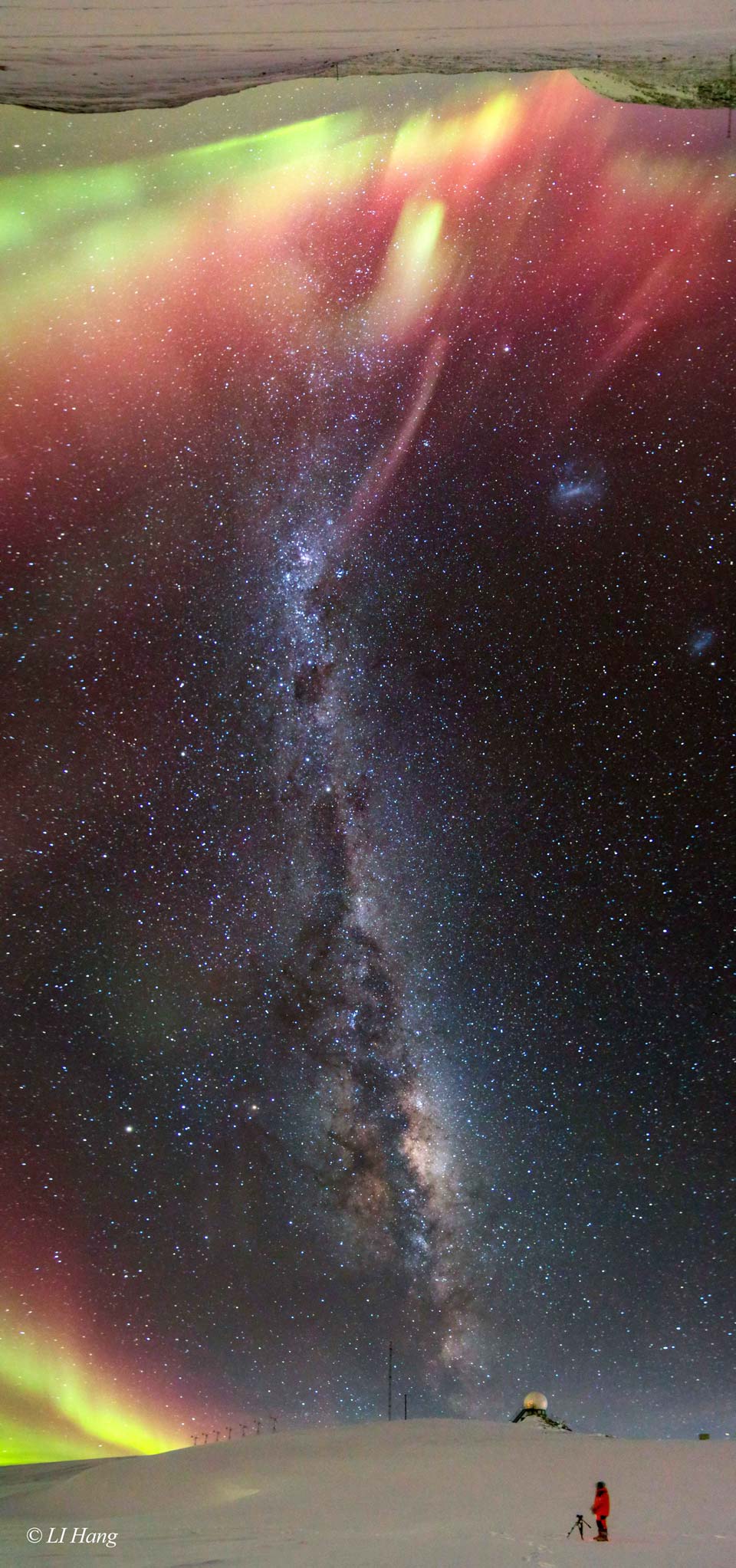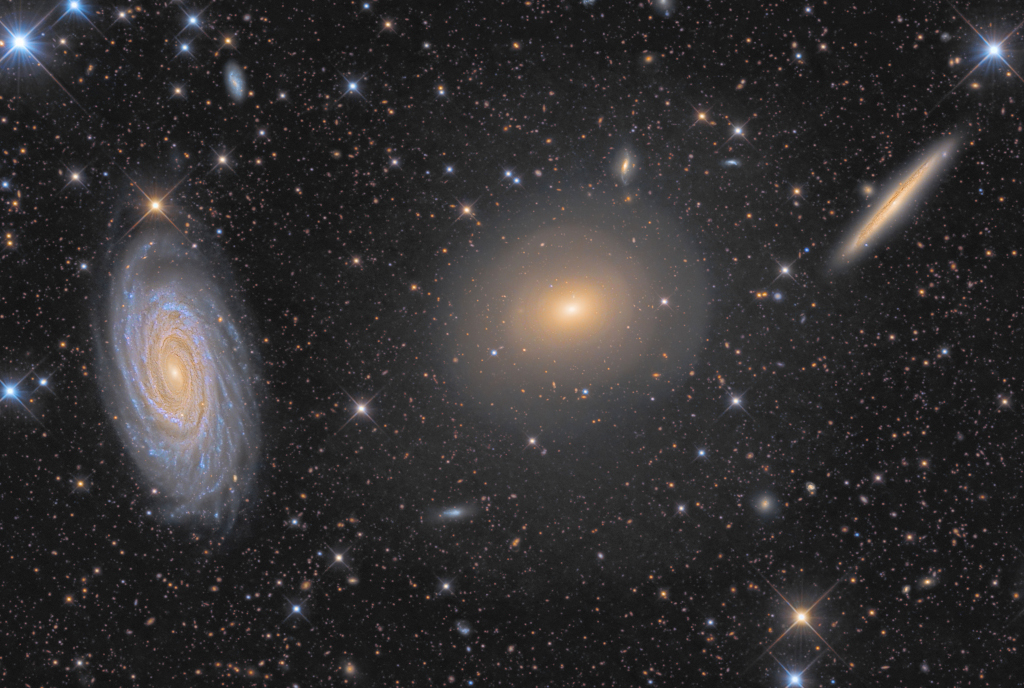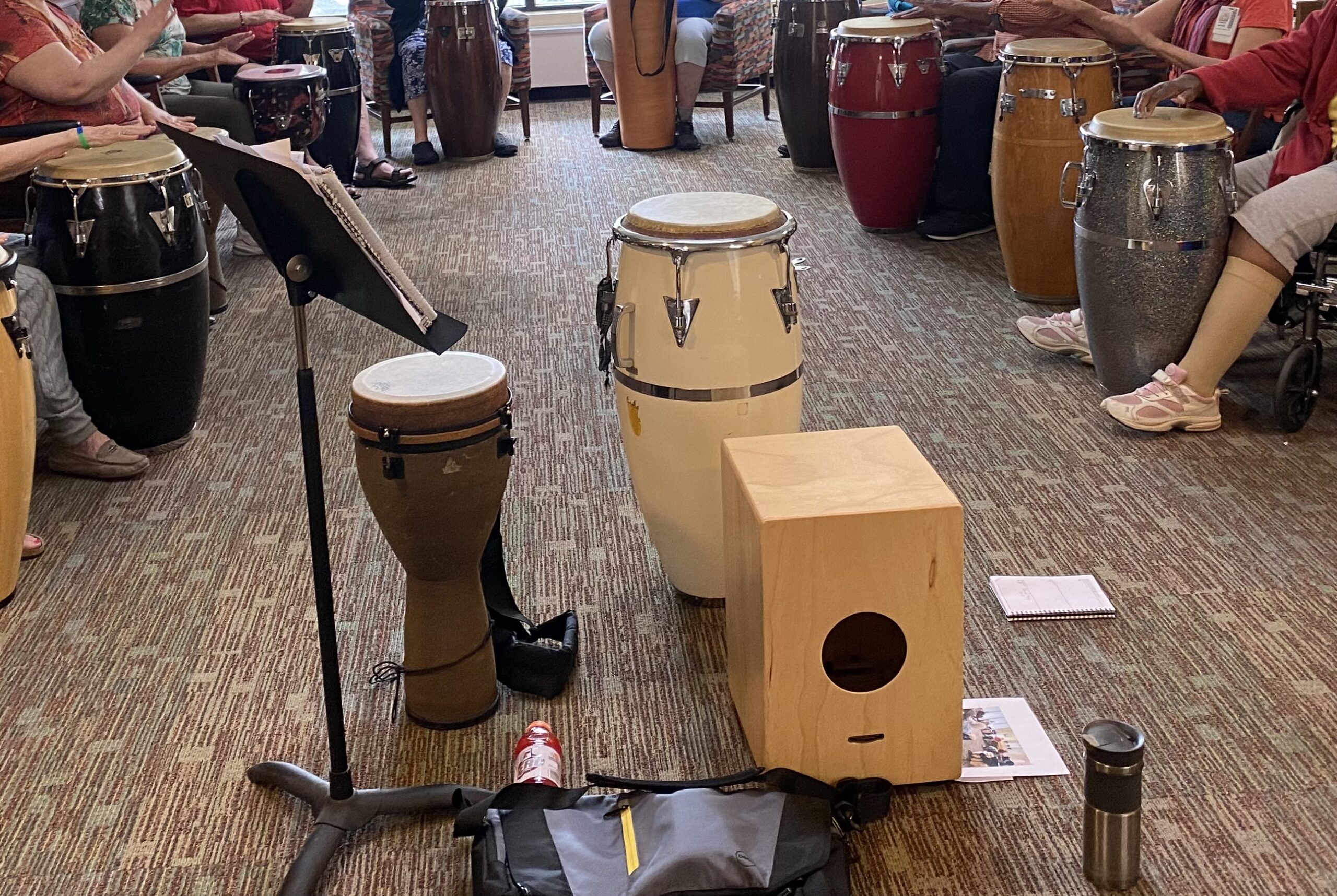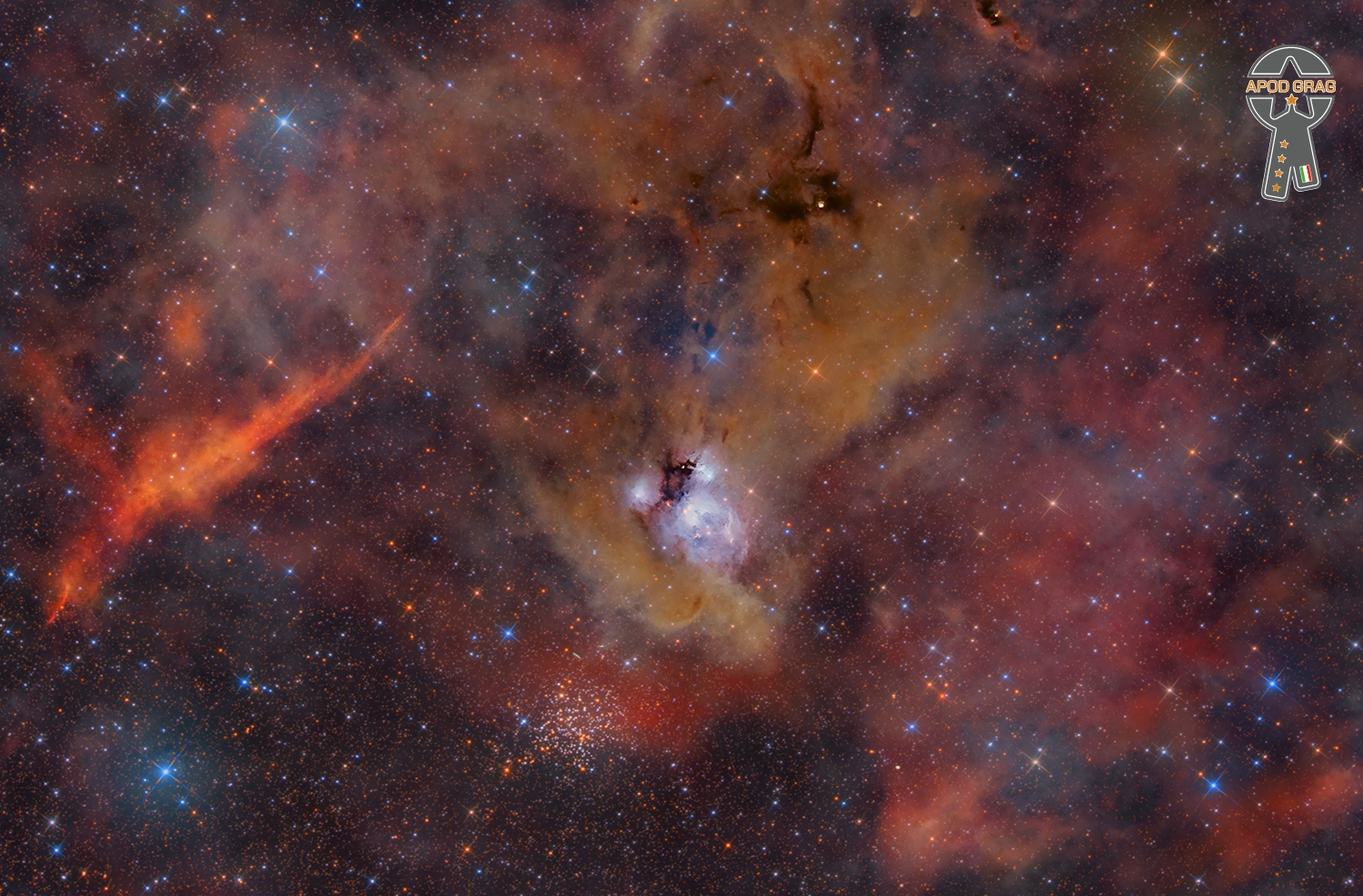Blog
Rhoda Scott (born July 3, 1938) is an American soul jazz organist and singer. She is nicknamed “The Barefoot Lady”.
Scott was born and raised in the Dorothy neighborhood of Weymouth Township, New Jersey, the first child to a Black travelling minister father and a white mother. She has six siblings. At 20 years old, Scott begain to play the organ in an R&B group. She soon founded her own groups, gigging around metro New York, eventually opening for Count Basie in Newark, where he invited her to play his Harlem club. In 1963, she recorded her first album, Live! at the Key Club (Tru-Sound/Prestige TSLP-15014). She also met Eddie Barclay, who paid $75 to acquire one of her songs, Hey Hey Hey that became a big hit.
more...In parts of Antarctica, not only is it winter, but the Sun can spend weeks below the horizon. At China‘s Zhongshan Station, people sometimes venture out into the cold to photograph a spectacular night sky. The featured image from one such outing was taken in mid-July of 2015, just before the end of this polar night. Pointing up, the wide angle lens captured not only the ground at the bottom, but at the top as well. In the foreground, a colleague is taking pictures. In the distance, a spherical satellite receiver and several windmills are visible. Numerous stars dot the night sky, including Sirius and Canopus. Far in the background, stretching overhead from horizon to horizon, is the central band of our Milky Way Galaxy. Even further in the distance, visible as extended smudges near the top, are the Large and SmallMagellanic Clouds, satellite galaxies near our huge Milky Way Galaxy.

Herbert Harper (2 July 1920 — 21 January 2012) was an American jazz trombonist of the West Coast jazz school.
Born in Salina, Kansas, he played swing music with Benny Goodman and Charlie Spivak in the 1940s and 1950s. Working on the West Coast jazz scene, he performed with such musicians as Stan Kenton, Bill Perkins and Maynard Ferguson, among others.
In June 1949, he was a member of the band backing Billie Holiday on her Just Jazz radio broadcast for AFRS in Los Angeles. Other band members were Neal Hefti (trumpet), Herbie Steward (clarinet, tenor saxophone), Jimmy Rowles (piano), Robert “Iggy” Shevak (bass) and Roy “Blinky” Garner (drums).
In 1954, he recorded several sessions as a member of Steve White‘s Hollywood-based quartet.
more...Angelo Chambers, 2 July 1924, Denton, Texas, USA, d. 7 June 1993, St. Paul, Minnesota, USA. While living in Dallas, Chambers worked for a while as a waiter at a blues club where he also acted as emcee and developed an engaging stage presence. Later, he appeared regularly at blues clubs in many Midwestern cities. His day job was a bus driver but whenever the opportunity arose he would be on stage, singing, occasionally playing drums, and introducing other acts with considerable panache. Although he lived in several other cities, he eventually settled in St. Paul, Minnesota. There, he led his own band, the Blue Birds, and also worked with a band led by Harmonica Tom Schafer. In 1991 he recorded the single, ‘Mean And Evil Woman’, which became a local hit, as did the b-side, ‘Cleo’. These tracks appeared on his sole album, which was completed not long before his death. A cassette was prepared for a launch, which Milwaukee Slim was able to attend even though he was failing in health. The album itself was released two years later and included ‘Standing On The Outside Crying’, ‘Sweet Little Angel’, ‘You Got Me Thinkin’’, ‘I’m A Legend’, ‘Double Trouble Blues’, ‘Mean And Evil Woman’, and ‘Mean Old World’, as well as his hit singles.
more...Ahmad Jamal (born Frederick Russell Jones; July 2, 1930 – April 16, 2023) was an American jazz pianist, composer, bandleader, and educator. For six decades, he was one of the most successful small-group leaders in jazz. He was a National Endowment for the Arts (NEA) Jazz Master and won a Lifetime Achievement Grammy for his contributions to music history.
Jamal was born Frederick Russell Jones in Pittsburgh, Pennsylvania, on July 2, 1930. He began playing piano at the age of three, when his uncle Lawrence challenged him to duplicate what he was doing on the piano. Jamal began formal piano training at the age of seven with Mary Cardwell Dawson, whom he described as having greatly influenced him. His Pittsburgh roots remained an important part of his identity (“Pittsburgh meant everything to me and it still does,” he said in 2001) and it was there that he was immersed in the influence of jazz artists such as Earl Hines, Billy Strayhorn, Mary Lou Williams, and Erroll Garner. Jamal also studied with pianist James Miller and began playing piano professionally at the age of fourteen, at which point he was recognized as a “coming great” by the pianist Art Tatum. When asked about his practice habits by a critic from The New York Times, Jamal commented that, “I used to practice and practice with the door open, hoping someone would come by and discover me. I was never the practitioner in the sense of twelve hours a day, but I always thought about music. I think about music all the time.
more...the Draco Group, is located in the northern constellation of (you guessed it) Draco, the Dragon. From left to right are face-on spiral NGC 5985, elliptical galaxy NGC 5982, and edge-on spiral NGC 5981, all found within this single telescopic field of view that spans a little more than the width of the full moon. While the group is far too small to be a galaxy cluster, and has not been catalogued as a compact galaxy group, the three galaxies all do lie roughly 100 million light-years from planet Earth. Not as well known as other tight groupings of galaxies, the contrast in visual appearance still makes this triplet an attractive subject for astroimagers. On close examination with spectrographs, the bright core of striking spiral NGC 5985 shows prominent emission in specific wavelengths of light, prompting astronomers to classify it as a Seyfert, a type of active galaxy. This impressively deep exposure hints at a faint dim halo along with sharp-edged shells surrounding elliptical NGC 5982, evidence of past galactic mergers. It also reveals many even more distant background galaxies.

more...
Leon “Ndugu” Chancler July 1, 1952 – February 3, 2018) was an American pop, funk, and jazz drummer. He was also a composer, producer, and university professor.
Born in Shreveport, Louisiana, on July 1, 1952, Leon Chancler was the youngest of seven children from the union of Rosie Lee and Henry Nathaniel Chancler. In 1960, the family relocated to Los Angeles, California.
By the time he finished college, Chancler had already performed with jazz artists such as the Gerald Wilson Big Band, Herbie Hancock, and recorded with Miles Davis, Freddie Hubbard, and Bobby Hutcherson.
He recorded frequently as a sideman in jazz, blues, and pop music, including the instantly recognizable drums on Michael Jackson‘s “Billie Jean“. In 1982, he received a Grammy nomination for Best Rhythm & Blues song for co-writing “Let It Whip”, made famous by the Dazz Band. Other musicians with whom Chancler worked during his career included George Benson, Stanley Clarke, the Crusaders, George Duke, John Lee Hooker, Hubert Laws, Thelonious Monk, Jean-Luc Ponty, Lionel Richie, Kenny Rogers, Patrice Rushen, Santana, Frank Sinatra, Donna Summer, the Temptations, Tina Turner, and Weather Report.
https://www.youtube.com/watch?v=K2TTyCdZwhA
more...Sameer Gupta (born July 1, 1976) is a Brooklyn-based jazz percussionist, tabla player, and composer. He is a co-founder of Brooklyn Raga Massive, the jazz ensemble The Supplicants and drummer for the Marc Cary Focus Trio. He has also worked with vidyA, Kosmic Renaissance, Grachan Moncur III, Victor Goines, Vincent Gardner, Sekou Sundiata, Sonny Simmons, Marcus Shelby, Calvin Keys, Richard Howell, Dayna Stephens, and Julian Lage.
The Jazz Observer called his playing kinetic, bass-heavy, and tender.
more...Rashied Ali, born Robert Patterson (July 1, 1933 – August 12, 2009) was an American free jazz and avant-garde drummer who was best known for performing with John Coltrane in the last years of Coltrane’s life.
Patterson was born and raised in Philadelphia, Pennsylvania. His family was musical; his mother sang with Jimmie Lunceford. His brother, Muhammad Ali, is also a drummer, who played with Albert Ayler. Ali, his brother, and his father converted to Islam.
Starting off as a pianist, he eventually took up the drums, via trumpet and trombone. He joined the United States Army and played with military bands during the Korean War. After his military service, he returned home and studied with Philly Joe Jones, then toured with Sonny Rollins.
more...James Henry Cotton (July 1, 1935 – March 16, 2017) was an American blues harmonica player, singer and songwriter, who performed and recorded with many fellow blues artists and with his own band. He also played drums early in his career.
Cotton began his professional career playing the blues harp in Howlin’ Wolf‘s band in the early 1950s. He made his first recordings in Memphis for Sun Records, under the direction of Sam Phillips. In 1955, he was recruited by Muddy Waters to come to Chicago and join his band. Cotton became Muddy’s bandleader and stayed with the group until 1965. In 1965, he formed the Jimmy Cotton Blues Quartet, with Otis Spann on piano, to record between gigs with the Muddy Waters band. He eventually left to form his own full-time touring group. His first full album, on Verve Records, was produced by the guitarist Mike Bloomfield and the singer and songwriter Nick Gravenites, who later were members of the band Electric Flag.
In the 1970s, Cotton played harmonica on Muddy Waters’ Grammy Award–winning 1977 album Hard Again, produced by Johnny Winter.
Cotton was born in Tunica, Mississippi. He became interested in music when he first heard Sonny Boy Williamson II on the radio. He left home with his uncle and moved to West Helena, Arkansas, finding Williamson there. For many years Cotton claimed that he told Williamson that he was an orphan and that Williamson took him in and raised him, a story he admitted in recent years is not true. However, Williamson did mentor Cotton during his early years.
more...William James Dixon (July 1, 1915 – January 29, 1992) was an American blues musician, vocalist, songwriter, arranger and record producer. He was proficient in playing both the upright bass and the guitar, and sang with a distinctive voice, but he is perhaps best known as one of the most prolific songwriters of his time. Next to Muddy Waters, Dixon is recognized as the most influential person in shaping the post–World War II sound of the Chicago blues.
Dixon’s songs have been recorded by countless musicians in many genres as well as by various ensembles in which he participated. A short list of his most famous compositions includes “Hoochie Coochie Man“, “I Just Want to Make Love to You“, “Little Red Rooster“, “My Babe“, “Spoonful“, and “You Can’t Judge a Book by the Cover“. These songs were written during the peak years of Chess Records, from 1950 to 1965, and were performed by Muddy Waters, Howlin’ Wolf, Little Walter, and Bo Diddley; they influenced a generation of musicians worldwide.
Dixon was an important link between the blues and rock and roll, working with Chuck Berry and Bo Diddley in the late 1950s.In the 1960s, his songs were adapted by numerous rock artists. He received a Grammy Award and was inducted into the Blues Hall of Fame, the Rock and Roll Hall of Fame, and the Songwriters Hall of Fame.
Dixon was born in Vicksburg, Mississippi, on July 1, 1915. He was one of fourteen children. His mother, Daisy, often rhymed things she said, a habit her son imitated. At the age of seven, young Dixon became an admirer of a band that featured pianist Little Brother Montgomery. He sang his first song at Springfield Baptist Church at the age of four. Dixon was first introduced to blues when he served time on prison farms in Mississippi as a young teenager.
more...
NGC 7129 is a reflection nebula located 3,300 light years away in the constellation Cepheus. A young open cluster is responsible for illuminating the surrounding nebula. A recent survey indicates the cluster contains more than 130 stars less than 1 million years old. NGC 7129 is located just half a degree from nearby cluster NGC 7142.
The nebula is rosebud-shaped; the young stars have blown a large, oddly shaped bubble in the molecular cloud that once surrounded them at their birth. The rosy pink color comes from glowing dust grains on the surface of the bubble being heated by the intense light from the young stars within. The ultra-violet and visible light produced by the young stars is absorbed by the surrounding dust grains. They are heated by this process and release the energy at longer infrared wavelengths as photographed by the Spitzer Space Telescope. The reddish colors in the false-colour infrared image suggest the distribution of hydrocarbon rich molecular material.

Lena Mary Calhoun Horne (June 30, 1917 – May 9, 2010) was an American dancer, actress, singer, and civil rights activist. Horne’s career spanned more than seventy years, appearing in film, television, and theatre. Horne joined the chorus of the Cotton Club at the age of sixteen and became a nightclub performerbefore moving to Hollywood.
Horne advocated for human rights and took part in the March on Washington in August 1963. Later she returned to her roots as a nightclub performer and continued to work on television while releasing well-received record albums. She announced her retirement in March 1980, but the next year starred in a one-woman show, Lena Horne: The Lady and Her Music, which ran for more than 300 performances on Broadway. She then toured the country in the show, earning numerous awards and accolades. Horne continued recording and performing sporadically into the 1990s, retreating from the public eye in 2000.
Lena Horne was born in Bedford–Stuyvesant, Brooklyn. Both sides of her family were African American. She belonged to the well-educated, upper stratum of Black New Yorkers at the time.
more...More Posts
- Sheikh Imam Day
- World Music with ALTAI KAI
- Daily Roots with Love Joys
- The Cosmos with M102
- Rashied Ali Day
- James Cotton Day
- Willie Dixon Day
- World Fusion with AKA Trio
- Daily Roots with Jennifer Lara
- The Cosmos with NGC 1073
- Maytisyahu Day
- Stanley Clarke Day
- Apostolos Nikolaidis Day
- Andrew Hill Day
- World Music with Carlos Núñez
- Daily Roots with Paula Clarke
- The Cosmos with M83
- Little Eva Day
- Julian Priester Day
- World Music with RAJERY